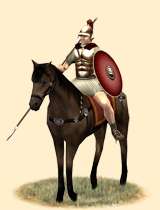Eqvites Romani (Camillan Roman Citizen Cavalry)
 |
Weapons | Defence | Mental | ||||||
|---|---|---|---|---|---|---|---|---|---|
| Primary | Secondary | Armour: | 10 | Morale: | 12 | ||||
| Type: | spear | sword | Shield: | 3 | Discipline: | impetuous | |||
| Attack: | 8 | 9 | Skill: | 8 | Training: | trained | |||
| Charge: | 27 | 15 | Recruitment | Other | |||||
| Lethality: | 0.15 | 0.13 | Soldiers: | 25 | Hit Points: | 1 | |||
| Range: | 0 | 0 | Cost: | 3042 | Mass: | 1 | |||
| Ammo: | 0 | 0 | Upkeep: | 761 | |||||
| Turns: | 1 | ||||||||

Eqvites Romani are the members of the Republic's leading classes, that have to serve as the legion's cavalry arm.
They can be recruited in the central Italian provinces Latium, Umbria, Etruria, Apulia, Liguria and Campania. These are the heartlands of the Res Publica, filled with our colonies founded during the epic struggles of the past centuries.
The equites are the roman citizen cavalry force. 300 of them, divided into ten turmae, are attached to each legion. They are now armed and armoured in Greek fashion with a hasta lance, a sword, a round parma equestris shield with a diameter of 50-80 cm, a crested helmet and wear a bronze muscle cuirass. Each eques has three horses and is accompanied by two grooms.
Historically, the equites were the members of the ordo equester and the sons of the families of the ordo senatorius, the two classes of the roman nobility, the wealthiest and most influential men.
This proud horsemen were the future leading men of Roma. Their small numbers and the formidable opposition of other nations more professional cavalry often limited their effect on the battlefield, so that they were rarely used for other tasks than securing the flanks of the heavy infantry.
Over many centuries the Romans had the reputation to be more willing than others to adopt new customs and techniques if they proved useful. This was seen as one of their greatest strengths. Earlier roman horsemen probably fought mainly as light cavalry with javelins until conflicts with other Italian and foreign powers heavy cavalry had taught them its effectiveness.
Normally every roman must have served at least ten years in the military before he was permitted to hold any political office. The eques had the duty to serve ten years, the infantryman 16 or 20 years in the case of national emergency, until he has completed his 46th year of life.